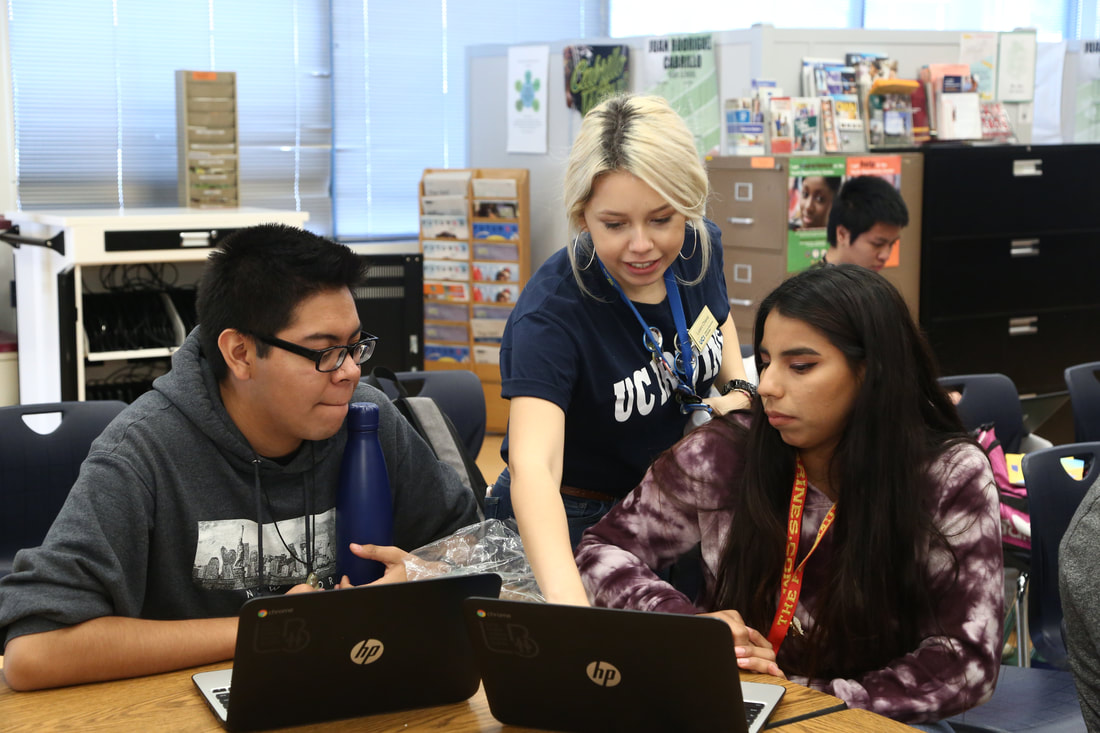EARLY OUTREACH, EARLY INNOVATOR
|
The Early Academic Outreach Program (EAOP) is one of the oldest programs in CFEP. It’s so established, in fact, that it predates CFEP entirely.
The program was established in 1976 by the University of California in response to the State Legislature's recommendation to expand post-secondary opportunities to all California students, including those who are first-generation, socioeconomically disadvantaged, and English-language learners. The program’s goal of increased access for educationally disadvantaged students to the University of California is grounded in the philosophy that preparing for success in college is not simply one of many options for young people; it is their right. Therefore, EAOP takes seriously the task of ensuring that EAOP students acquire the skills and knowledge they will need to succeed at the University of California and at other institutions of higher education. |
UCI EAOP reaches, on average, around 12,000 K-12 students a year through its various academic enrichment programs, academic advising, test preparation programs, and college enrollment workshops.
Simply put, EAOP gets students into college. In 2019 – the last full year in which there is complete data – 84 percent of EAOP participants enrolled in a postsecondary institution, with more than 50 percent enrolling in a four-year university. UCI is the No.1 destination for EAOP participants, among UC schools, followed by UCLA.
“Everything is built around the EAOP,” said Stephanie Reyes-Tuccio, assistant vice chancellor, educational partnerships. “At its core, the EAOP helps ensure students are taking and passing A-G courses and filling out their FAFSA and college application. Helping students and families make these critical steps is job number one.”
Simply put, EAOP gets students into college. In 2019 – the last full year in which there is complete data – 84 percent of EAOP participants enrolled in a postsecondary institution, with more than 50 percent enrolling in a four-year university. UCI is the No.1 destination for EAOP participants, among UC schools, followed by UCLA.
“Everything is built around the EAOP,” said Stephanie Reyes-Tuccio, assistant vice chancellor, educational partnerships. “At its core, the EAOP helps ensure students are taking and passing A-G courses and filling out their FAFSA and college application. Helping students and families make these critical steps is job number one.”
|
While EAOP or an equivalent exists on every UC campus, each campus has the autonomy to structure its programming how it best sees fit.
Beginning in 2018, UCI EAOP shifted to a “cohort model,” which allows CFEP staff to work deliberately with 50 students per grade level at 20 school sites - 4,000 students total per year. Students receive a host of services, including: one-on-one academic advising, transcript analysis and academic course planning, college visits and campus tours, and support on registering for the SAT/ACT, financial aid, and college applications. Students at participating schools who are not in an EAOP cohort are still invited to school-wide workshops and presentations led by CFEP staff. “After switching to this more intimate model, we’ve seen an increase in the number of students who apply to a UC or CSU,” said Ashley Cheri, EAOP director. “Roughly 62 percent of the cohort students the past three years have applied to UCI, which is about a 60 percent increase from years prior.” |
EAOP also helped immensely with A-G completion rates amid the pandemic. Despite the circumstances brought on by COVID-19, there was only a 3 percent decrease in the number of EAOP students who completed their A-G coursework (coursework necessary for admission to a UC school).
EAOP works across Orange County and into Los Angeles – partner districts include Anaheim Union HIgh School District, Compton Unified School District, Long Beach Unified School District, Santa Ana Unified School District, as well as additional individual schools in Orange and Los Angeles county.
EAOP works across Orange County and into Los Angeles – partner districts include Anaheim Union HIgh School District, Compton Unified School District, Long Beach Unified School District, Santa Ana Unified School District, as well as additional individual schools in Orange and Los Angeles county.
/
We just want kids to go to college. Whether that’s (at UCI), another UC, a Cal State, a community college or somewhere else, we want the students to have access and provide them with opportunities to see that they belong, and that there are people looking out for them and wanting them to succeed.
Director, EAOP |
Like all of the programs hosted by CFEP, EAOP is focused on getting students into college, not exclusively UCI.
“We just want kids to go to college,” Cheri said. “Whether that’s here, another UC, a Cal State, a community college or somewhere else, we want the students to have access and provide them with opportunities to see that they belong, and that there are people looking out for them and wanting them to succeed.” EAOP is also home to many subprograms dedicated to college preparation and admission. This includes the President’s Pre-College Scholars, which takes high-achieving students identified by the UC Office of the President, and provides intensive, intentional support with the goal that the students be admitted into and attend a UC school. Reaching more than 10,000 students per year for the past 45 years, EAOP has easily impacted hundreds of thousands of students and families in Southern California. By improving the outcomes of students, year-by-year, entire schools are transformed over the course of decades. |
“The EAOP works because of our collaborative nature and because we work one-on-one with students, and then support the whole-school model,” Cheri said. “We recognize that the success of our goals does not come solely from the success of our cohort participants, but rather by making the schools a better place for all students to be at.”
The preceding story is part of the "CFEP: 25 Years of Impact" series, honoring the people, programs and partnerships that have helped impact millions of students, teachers and families over the past quarter century. View the entire series here.





